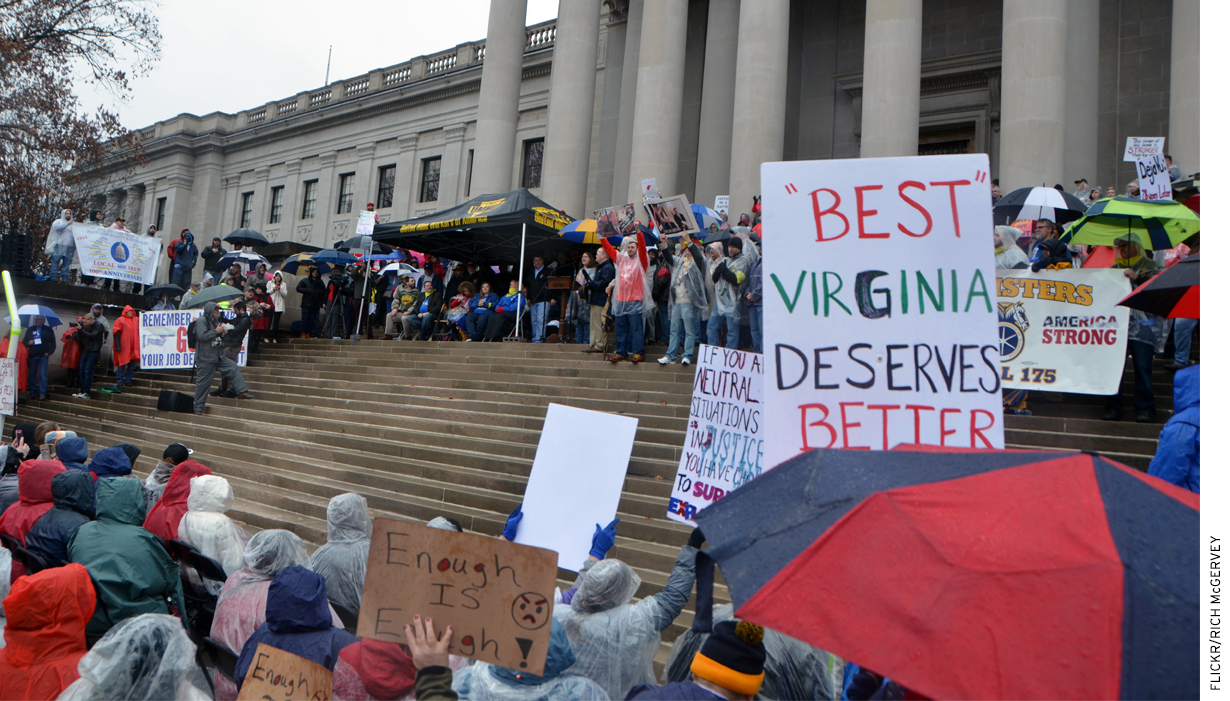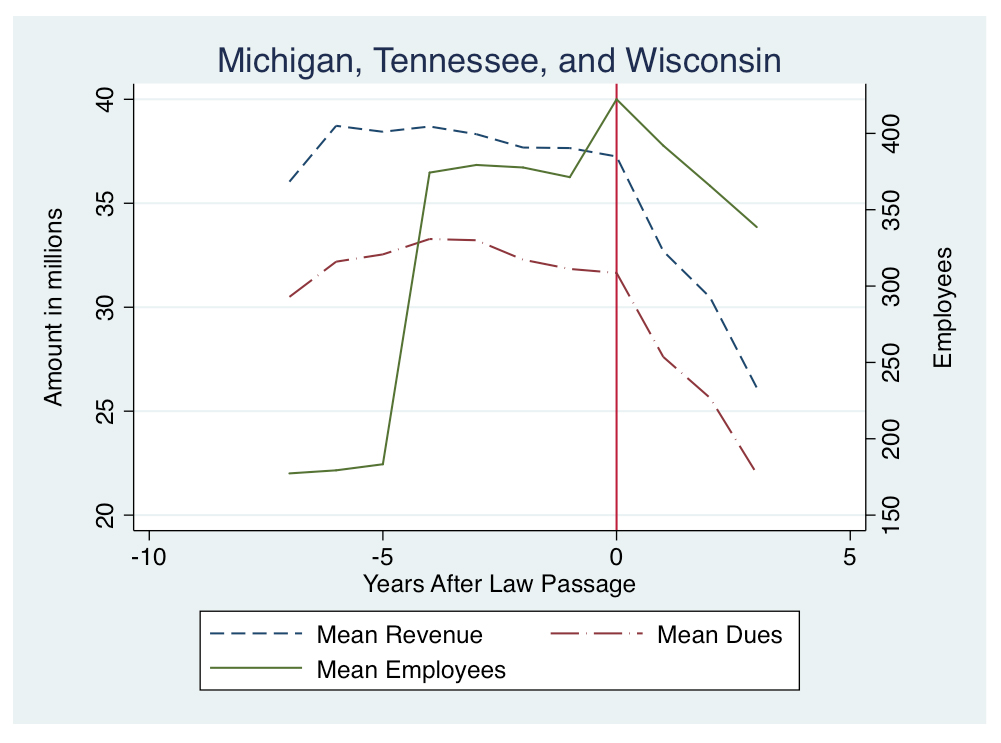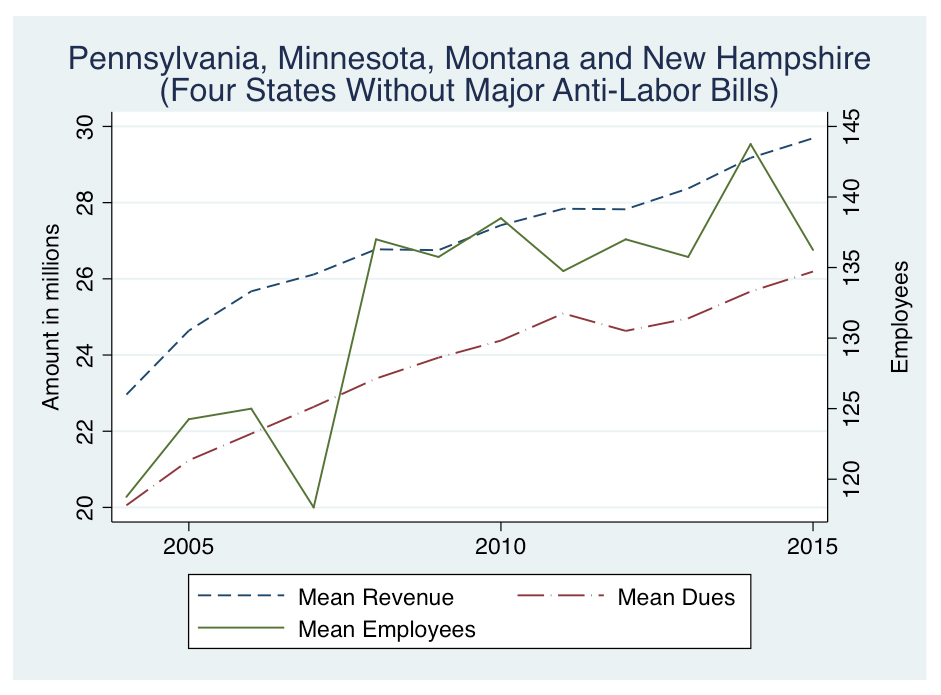
Last week, West Virginia teachers returned to their classrooms, ending a nine-day strike that closed every school in the state’s 55 counties. Teachers and other school workers went back to work after they had secured a 5 percent pay raise and other concessions, and the strike was deemed a success. Reports suggest that teachers in Oklahoma and Arizona are considering strikes or other actions.
The strike was surprising because West Virginia is not considered a union-friendly state. Indeed, strikes are illegal in West Virginia, and in 2017, a right-to-work law went into effect. Such laws prohibit unions from collecting “agency fees,” funds that all unit workers—even nonmembers—must pay for unions’ representative and administrative activities. Many contend that, without agency fees, unions have trouble organizing and lobbying, and scholars have shown that right-to-work laws do indeed cut into union resources and make it harder for unions to mobilize workers politically. The fact that the West Virginia teachers unions, which should have been hobbled by the new right-to-work law, could muster such an impressive strike was noteworthy.
West Virginia teachers are not alone in facing this new legal environment. With its right-to-work law, West Virginia joined a growing list of states curtailing the rights of unions with restrictions on collective bargaining and the collection of agency fees. The Janus v. AFSCME Council 31 case currently before the Supreme Court threatens to get rid of agency fees for all public sector unions in the U.S. Against this legal backdrop, some on the left have looked to West Virginia with optimism. They predict that labor may become increasingly activist, even as laws become more unfriendly to unions. Pro-labor websites have proclaimed “West Virginia Teachers Are Showing How Unions Can Win Power Even If They Lose Janus” and “West Virginia Teachers Point the Way: Labor After Janus.” Others predict a resurgence of the long-declining labor movement.
Have West Virginia teachers demonstrated a new way to achieve power in a post-Janus world? Was this the beginning of a labor movement revival? I contend that these interpretations mistake short-term, surface-level victories for deeper, more institutionalized forms of strength. Successful strikes are just that: successful strikes. They do not necessarily signal a change in long-term union power.
The Two Faces of Power
In 1962, political scientist Peter Bachrach and economist Morton S. Baratz wrote about what they called the “two faces of power”—two different types of power, one of which is more significant than the other. A person has “the first face of power” when he convinces someone else to do something they might not do otherwise. Getting a 5 percent salary increase passed when the Republican-controlled West Virginia government initially only wanted to pass a 1 percent salary increase exemplifies the first face of power.
The “second face of power,” however, is harder to detect. Someone has this type of power when she decides the topic of discussion in the first place or has the ability to shape an agenda through her anticipated reaction. For example, if West Virginia legislators had initially proposed a 5 percent raise for teachers because they knew that the teachers would engage in a statewide strike over anything less, we might say that the teachers had demonstrated the second face of power.
In reality, legislators did not anticipate the strike because the West Virginia teachers unions have likely become weaker since the passage of right-to-work. While their strike certainly demonstrated an impressive show of impromptu force, it came from weakness rather than strength. After all, if unions weren’t already on the losing side, then legislatures wouldn’t have considered the proposals against them in the first place.
Trends in Teachers Union Strength
We can see that teachers unions in states passing anti-labor bills have become weaker by looking at how their resources have changed in the wake of right-to-work legislation. Public sector unions are required to disclose financial information because of their tax status, and through their tax forms, called “990s,” we can map teachers unions’ yearly revenue and dues received over time. We also can track how many employees they have.
If collective bargaining restrictions or right-to-work laws weaken unions, we would expect to see the amount of union revenue and dues and the number of employees fall following the passage of such laws. While teachers union membership rates are not available annually by state, decreased revenue and dues would suggest that unions are losing members and funds, meaning their ability to elect and pressure politicians through voting power and public opinion campaigns is eroding. In a more abstract sense, this would be evidence that they have lost some of their ability to shape the debate through the second face of power.
Tax data for the West Virginia teachers unions after its state passed a right-to-work law are not available because the law went into effect so recently. However, other states have passed right-to-work laws and bans or restrictions on collective bargaining in recent years. Below, I display the average amount of revenue and dues and the average number of employees for the state teachers unions in Michigan, Tennessee, and Wisconsin. In each figure, the red vertical line indicates the year that either a right-to-work law or restriction on collective bargaining was enacted. Financial information is in 2015 dollars.

In Michigan, a right-to-work law was passed in 2012, and the amount unions earned in revenue and dues fell in the years following the bill’s passage. Employee numbers, however, remained stable. In Tennessee, collective bargaining for educators was replaced with “collaborative conferencing” in 2011. This meant that school boards were to consult with teachers but had the final say on salaries, working conditions, and other job provisions. The amount of revenue and dues and the number of employees peaked in 2010, prior to the passage of the bill in 2011. They continued to fall thereafter. The Wisconsin Education Association Council saw a similar pattern, with the amount of dues and revenue and the number of employees falling in the wake of Act 10, which was passed in 2011 and curtailed the scope of collective bargaining for teachers and other public sector employees.
Contrast these trends with trends in Pennsylvania, Minnesota, Montana, and New Hampshire, four states that also had Republican legislatures at various times throughout this period but did not pass this kind of legislation. As the figure below makes clear, unions in these states did not experience the same dramatic drop-off in revenue, dues, or employees seen in Michigan, Wisconsin, and Tennessee. Overall, resources have remained steady or even increased.

While these are descriptive trends, they support what other scholars have already shown: states that pass labor-restrictive laws stifle the power of labor unions.
So What Can We Learn from West Virginia?
The West Virginia educators admirably turned out and accomplished their goals, but they did so as a last resort. While union watchers may be correct that labor will become more activist as legislatures and the Supreme Court turn against them, this activism will not reflect a strengthening of unions. Rather, new labor actions will come from employees who have lost their allies in power, their institutional protections, and, as a result, their manpower and resources. In the long term, this may generate new membership and resources, helping workers gain back some of their “second face” power. Or it may represent a new type of unionism where victories come from winning individual battles rather than setting a policy agenda through organizational strength.
— Leslie Finger
Leslie Finger is Lecturer on Government and Social Studies at Harvard University.


